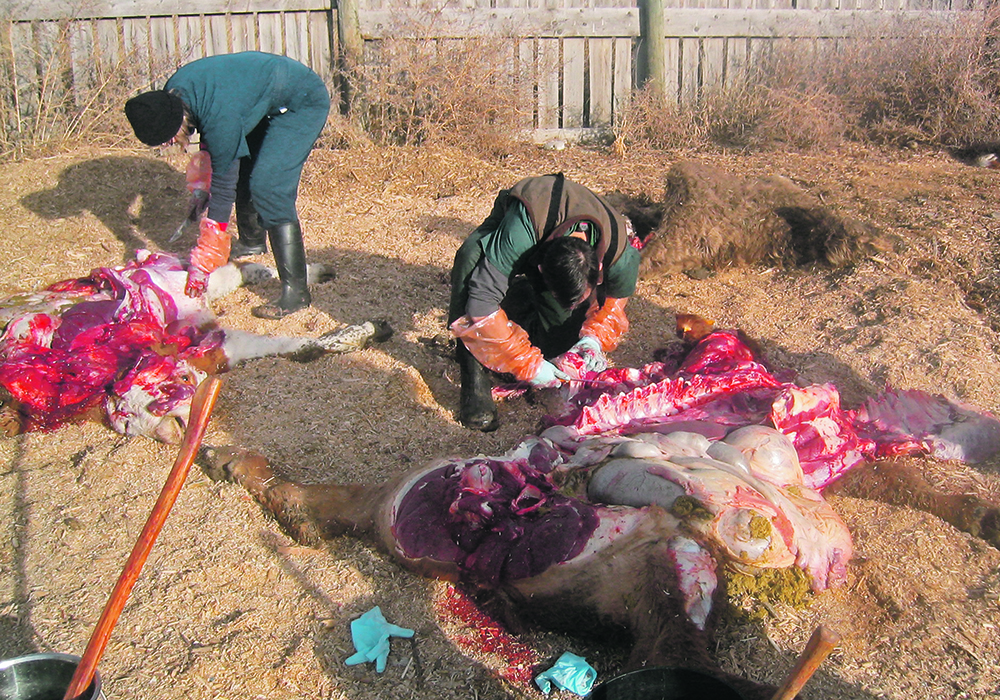Livestock producers sometimes balk at the expense, but a veterinarian says it can be good to know what’s behind a death
If an animal dies from an unknown cause, discovery of that cause can help avoid further deaths.
Samples and photos sent to a veterinarian are a first step. The vet might determine whether the animal died from hardware, pneumonia, plant poisoning, liver flukes or some other problem that might be preventable.
Findings of disease, parasites or nutritional deficiency in the herd can indicate ways to improve health management.
University of Calgary veterinary instructor Dr. Eugene Janzen says there may be nothing a producer can do to prevent the same problem if it’s an isolated incident or a freak accident.
“But when dealing with calf scours, respiratory disease, or anything contagious, you need to know immediately to try to prevent spread or manage the problem in the rest of the herd,” he says.
There may be additional concern if it’s a pathogen that could spread to humans, such as salmonellosis or cryptosporidiosis.
“And sometimes it becomes important to determine if it’s a disease that might affect other herds,” says Janzen.
“Today most large feed yards routinely do necropsies as part of their database and as a way to monitor treatment response.”
Cow-calf producers may be less likely to ask their veterinarian to do a necropsy because of the expense.
“When I tell them it might start at $300 to $400 and even more if we need additional tests, they might decide to let the coyotes do the post-mortem.”
Yet if more animals die, the owner might wish he or she had spent the money to figure it out.
“This is especially important this year in the drought. Our lab and veterinarians have made diagnoses of blue-green algae poisoning,” says Janzen.
The drought has also led to water toxicity that could lead to a sulfate-induced “polio” or some other problem.
“If a rancher has several animals that need treatment, he will probably ask for help. A veterinarian would do necropsies or examine as many animals, sick or dead, as necessary to determine the diagnosis and outline a course of action,” says Janzen.
But if one calf dies suddenly, is it the start of an outbreak? If a cow aborts just ahead of calving season, is it the beginning of an abortion storm?
“We encourage producers to create a bank of information based on lab reports but they can also bank tissues — freezing dead calves, perhaps in an old granary or under a snowbank, to preserve them. If there’s only one that dies, there may be no need for a necropsy. If others die, however, you’ll have a group to examine,” he says.
Some veterinarians make diagnoses using photos. The producer dissects the calf, takes pictures of various body cavities and organs and keeps the photos on the computer. This can help a veterinarian later if a diagnosis is needed.
“If photos are combined with saved tissues, this is helpful. At the UCVM, we encourage our fourth-year students to do this.
“Most veterinarians and pathologists still want to smell the cadaver and feel the tissues, saying digital images are not as good. But images are better than nothing and can give clues, especially if the producer doesn’t want to haul a dead carcass a long way to be examined.”
Janzen said availability of modern molecular tests limit the need for fresh tissue.
“For instance, in a BVD outbreak on a ranch, if dead animals were dragged into the bushes and half eaten by scavengers, the veterinarian could still take samples of skin and send them to a diagnostic lab.”
It may not be too late for reliable diagnosis.
“In Western Canada we’ve had some success figuring out abortions because of these molecular tests. You can take the brain from a fetus that’s just been expelled by the cow, and make a diagnosis of neosporosis, for instance. Success rate with diagnosing abortions has increased significantly,” says Janzen.
As an example, in 2001 foot-and-mouth disease percolated within the United Kingdom for three weeks before it was identified, partly because farmers didn’t consult veterinarians about lame animals.
“I feel it is in the interest of society to help us with critical diagnoses,” says Janzen.
“Our livestock industry has suffered, and producers haven’t engaged veterinarians or veterinary support to the degree they did in earlier years because of the costs. Thus we don’t know which diseases are zoonoses to be concerned about or know very much about exotic or uncommon diseases in our livestock populations.”

Diagnostic labs and support have been de-emphasized in North America in the past few decades, he contends.
“Part of the reason is that we’ve passed the cost on to the producer, and often the cost of that information is prohibitive,” he says.
However, some provinces subsidize necropsies, so producers are more willing to have them done.
Janzen recalls a case in which a lab report on a dead calf indicated it died of blackleg, but the owner was adamant it had been properly vaccinated so samples were sent for culture.
“When the culture came back, there was not a single clostridial organism in those muscles. It was a four-plus Pasteurella multocida, which is an exotic disease found in Africa and Asia called hemorrhagic septicemia.
“Pasteurella multocida is common in feed yards, except there is a different strain of that organism that causes this septicemic disease that can mimic blackleg. We sent that sample to Ames, Iowa, and got it typed.”
Janzen said it was the first case of that disease ever reported in Canadian cattle.
“We need to keep looking at odd cases to make sure an outbreak does not occur. We want to know if it’s one isolated mortality and not the tip of the iceberg, or the index case that might be followed by many others.”















